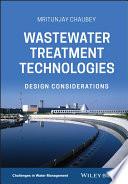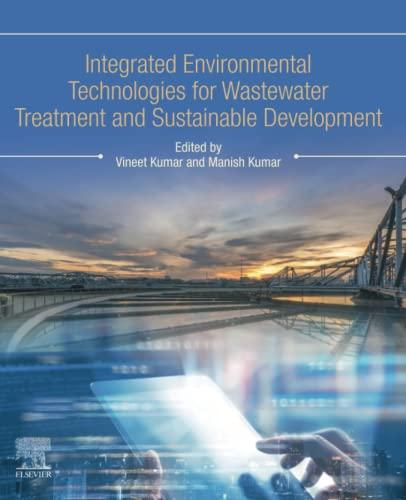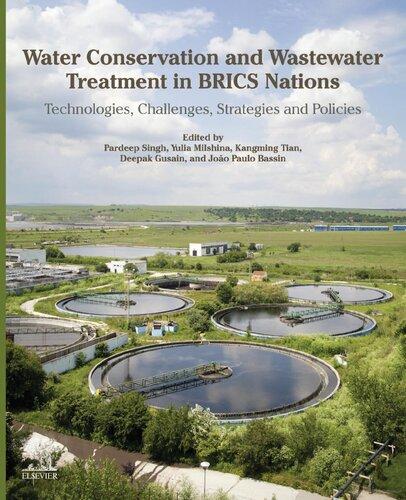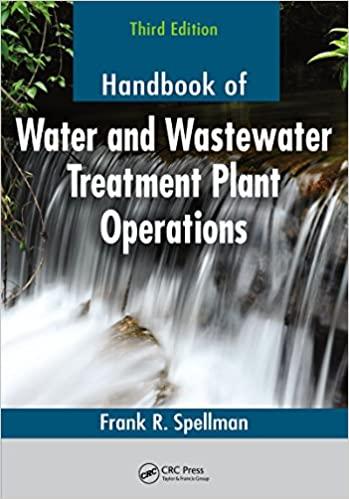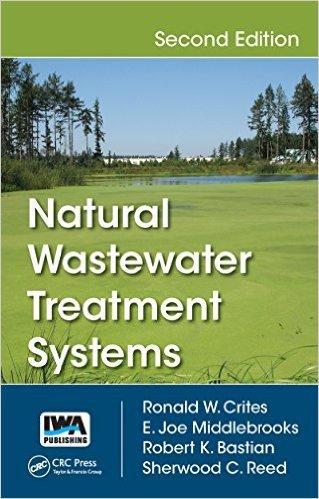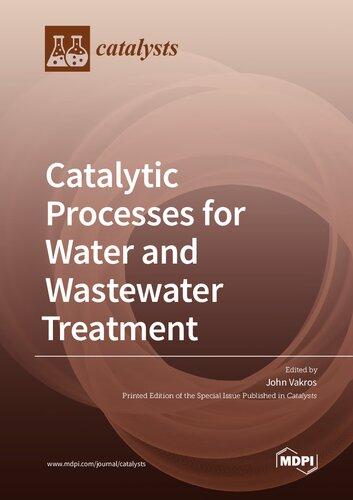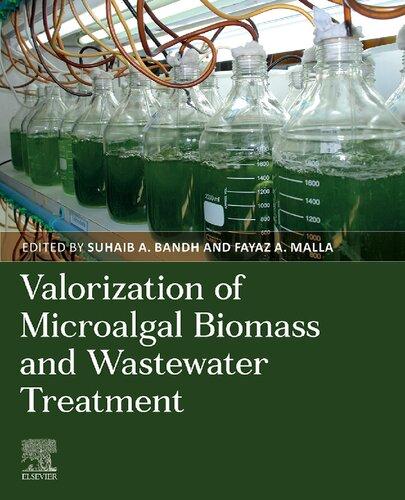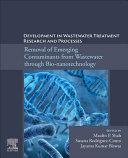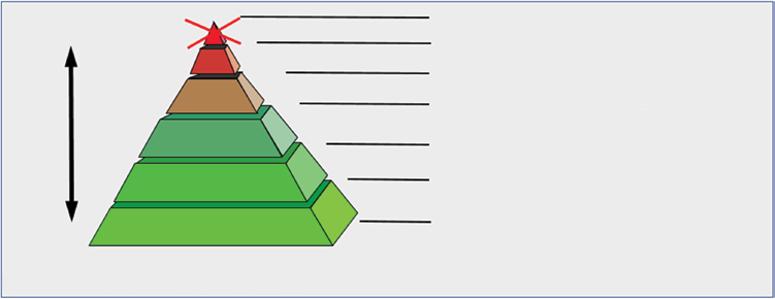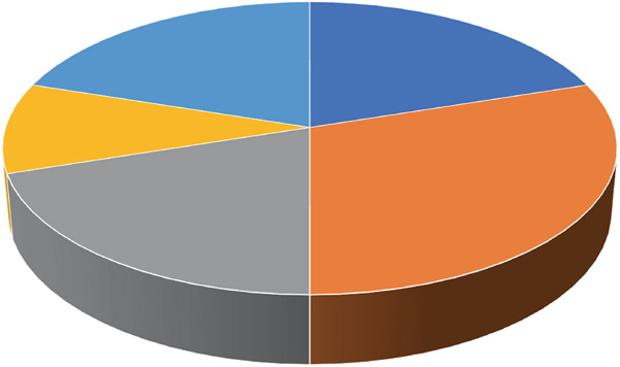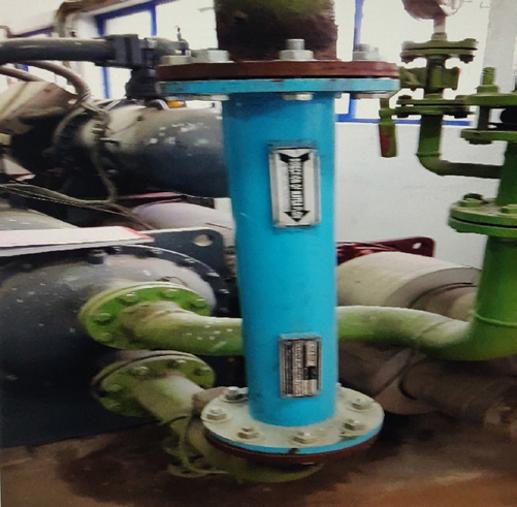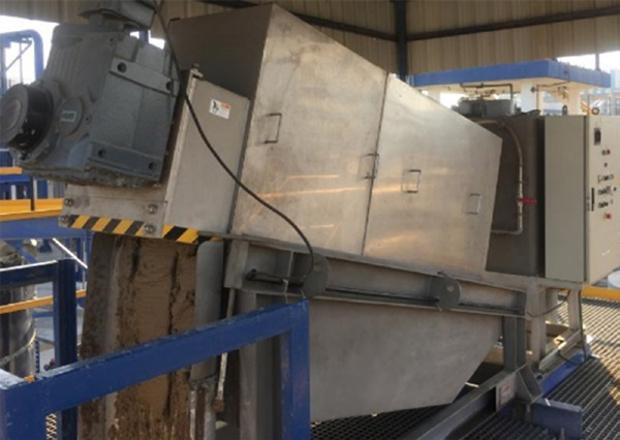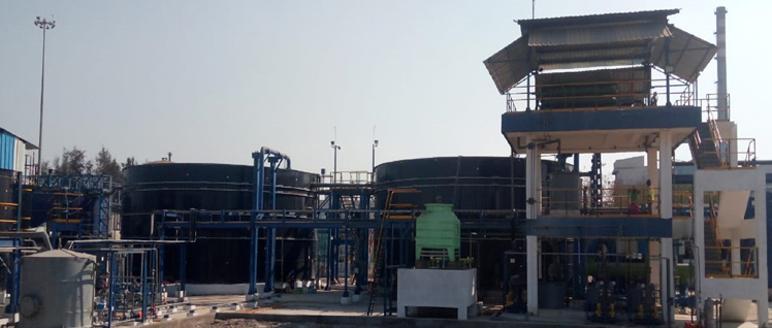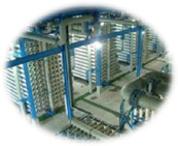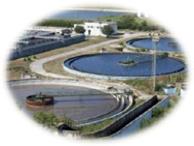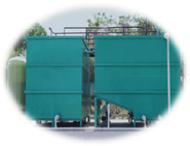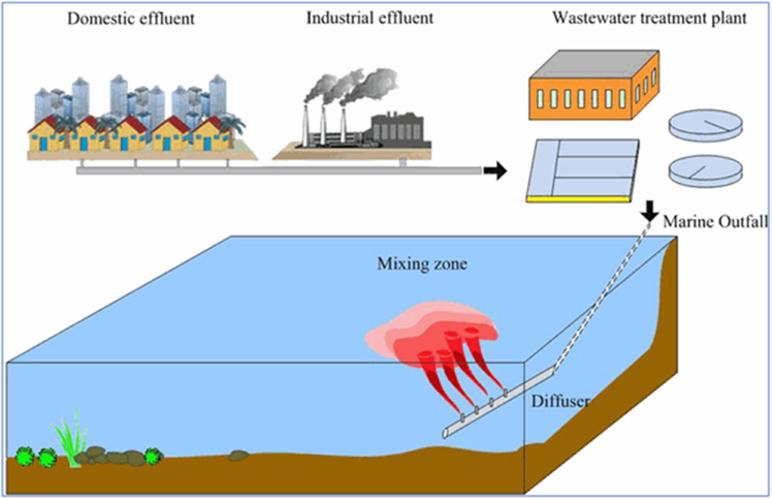Challenges in Water Management Series
Editor:
Justin Taberham
Publications and Environment Consultant, London, UK
Titles in the series:
Water Harvesting for Groundwater Management: Issues, Perspectives, Scope, and Challenges
Partha Sarathi Datta
2019
ISBN: 978-1-119-47190-5
Smart Water Technologies and Techniques: Data Capture and Analysis for Sustainable Water Management
David A. Lloyd Owen 2018
ISBN: 978-1-119-07864-7
Handbook of Knowledge Management for Sustainable Water Systems
Meir Russ 2018
ISBN: 978-1-119-27163-5
Industrial Water Resource Management: Challenges and Opportunities for Corporate Water Stewardship
Pradip K. Sengupta
2017
ISBN: 978-1-119-27250-2
Water Resources: A New Water Architecture
Alexander Lane, Michael Norton, and Sandra Ryan
2017
ISBN: 978-1-118-79390-9
Urban Water Security
Robert C. Brears
2016
ISBN: 978-1-119-13172-4
Wastewater Treatment Technologies
Design Considerations
Mumbai, India
Mritunjay Chaubey
This edition first published 2021 © 2021 John Wiley & Sons Ltd
All rights reserved. No part of this publication may be reproduced, stored in a retrieval system, or transmitted, in any form or by any means, electronic, mechanical, photocopying, recording or otherwise, except as permitted by law. Advice on how to obtain permission to reuse material from this title is available at http://www.wiley.com/go/permissions.
The right of Mritunjay Chaubey to be identified as the author of this work has been asserted in accordance with law.
Registered Offices
John Wiley & Sons, Inc., 111 River Street, Hoboken, NJ 07030, USA
John Wiley & Sons Ltd, The Atrium, Southern Gate, Chichester, West Sussex, PO19 8SQ, UK
Editorial Office
9600 Garsington Road, Oxford, OX4 2DQ, UK
For details of our global editorial offices, customer services, and more information about Wiley products visit us at www.wiley.com.
Wiley also publishes its books in a variety of electronic formats and by print-on-demand. Some content that appears in standard print versions of this book may not be available in other formats.
Limit of Liability/Disclaimer of Warranty
While the publisher and authors have used their best efforts in preparing this work, they make no representations or warranties with respect to the accuracy or completeness of the contents of this work and specifically disclaim all warranties, including without limitation any implied warranties of merchantability or fitness for a particular purpose. No warranty may be created or extended by sales representatives, written sales materials or promotional statements for this work. The fact that an organization, website, or product is referred to in this work as a citation and/or potential source of further information does not mean that the publisher and authors endorse the information or services the organization, website, or product may provide or recommendations it may make. This work is sold with the understanding that the publisher is not engaged in rendering professional services. The advice and strategies contained herein may not be suitable for your situation. You should consult with a specialist where appropriate. Further, readers should be aware that websites listed in this work may have changed or disappeared between when this work was written and when it is read. Neither the publisher nor authors shall be liable for any loss of profit or any other commercial damages, including but not limited to special, incidental, consequential, or other damages.
Library of Congress Cataloging-in-Publication Data
Names: Chaubey, Mritunjay, author.
Title: Wastewater treatment technologies : design considerations / Mritunjay Chaubey, Mumbai, India.
Description: Hoboken : Wiley-Blackwell, 2021. | Series: Challenges in water management series | Includes bibliographical references and index.
Identifiers: LCCN 2020032111 (print) | LCCN 2020032112 (ebook) | ISBN 9781119765226 (hardback) | ISBN 9781119765240 (adobe pdf) | ISBN 9781119765257 (epub)
Subjects: LCSH: Sewage–Purification. | Sewage disposal plants. | Water reuse.
Classification: LCC TD745 .C37 2021 (print) | LCC TD745 (ebook) | DDC 628.3–dc23
LC record available at https://lccn.loc.gov/2020032111
LC ebook record available at https://lccn.loc.gov/2020032112
Cover Design: Wiley
Cover Image: Maximilian Stock Ltd./Getty Images
Set in 9.5/12.5pt STIXTwoText by SPi Global, Pondicherry, India
10 9 8 7 6 5 4 3 2 1
Contents
Series Editor Foreword vii
Preface and Acknowledgments ix
List of Abbreviations xi
1 Global Perspective of Wastewater Treatment 1
1.1 Global Wastewater Treatment Scenario 1
1.2 The UN Sustainable Development Agenda for Wastewater 2
1.3 Global Market Size 4
1.4 Global Best Practices 4
1.5 Embedding Sustainability into Wastewater Treatment 7
1.6 Sustainable Sources for Industrial Water 11
1.7 Deep Sea Discharge as an Alternative to Minimize Human and Environmental Health Risks 13
1.8 Environmental Rule of Law 16
1.9 Trends in Wastewater Treatment Technology 17
2 Wastewater Characteristics 19
2.1 Wastewater Characteristics of Various Industries 19
2.2 Wastewater Characteristics and Measuring Methodology 38
3 Wastewater Treatment Technologies 67
3.1 Overview of Wastewater Treatment Technologies 67
3.2 Primary Treatment 68
3.3 Secondary Treatment 73
3.4 Tertiary Treatment 89
3.5 Sludge Dewatering 93
3.6 Zero Liquid Discharge 100
4 Design Considerations 103
4.1 Screening 104
4.2 Equalization Unit 105
4.3 Dissolved Air Flotation 106
4.4 Clariflocculator 108
4.5 Conventional Activated Sludge 110
4.6 Moving Bed Biofilm Reactor 120
4.7 Membrane Bioreactor 124
4.8 Chlorination Unit 130
4.9 Pressure Sand Filter 131
4.10 Activated Carbon Filter 133
4.11 Ultrafiltration 135
4.12 Reverse Osmosis 140
4.13 Evaporator with Crystallizer 146
4.14 Filter Press 149
4.15 Belt Press 152
4.16 Centrifuge 153
4.17 Gravity Thickener 155
5 Advance Sustainable Wastewater Treatment Technologies 158
5.1 Scaleban 159
5.2 Forward Osmosis 162
5.3 Activated Glass Media Filter 165
5.4 Vacuum Distillation 168
5.5 Volute 173
5.6 Solar Detoxification 174
5.7 Sustainable Wastewater Treatment 181
6 Zero Liquid Discharge 184
6.1 ZLD Technologies 185
6.2 ZLD Technologies: Techno-Economic Evaluation 192
6.3 Feasibility Study of ZLD 194
7 Wastewater Treatment Plant Operational Excellence and Troubleshooting 204
7.1 Wastewater Treatment Issues 204
7.2 Wastewater Stream Identification, Characterization, and Segregation 205
7.3 Operation and Troubleshooting for Preliminary Treatment System 205
7.4 Operation and Troubleshooting for Primary Treatment System 206
7.5 Operation and Troubleshooting for Secondary Biological Treatment System 206
7.6 Operation and Troubleshooting for Tertiary Treatment System 213
7.7 Wastewater Sampling 219
7.8 Operation Records and Daily Log Sheet 220
7.9 Microbiology Fundamentals 220
7.10 Biological Wastewater Treatment Factors 223
7.11 Lab Testing Activity and Support 224
7.12 Best Practices for Pipe Line Sizing 226
7.13 Best Practices for Instrument Operation 226
7.14 Wastewater Online Monitoring Process 227
7.15 Wastewater Characteristics Monitoring Parameters 228
7.16 Effluent Treatment Plant Operating Procedure 229
Glossary 231 Index 234
Series Editor Foreword – Challenges in Water Management
The World Bank in 2014 noted:
Water is one of the most basic human needs. With impacts on agriculture, education, energy, health, gender equity, and livelihood, water management underlies the most basic development challenges. Water is under unprecedented pressures as growing populations and economies demand more of it. Practically every development challenge of the 21st century – food security, managing rapid urbanization, energy security, environmental protection, adapting to climate change – requires urgent attention to water resources management.
Yet already, groundwater is being depleted faster than it is being replenished and worsening water quality degrades the environment and adds to costs. The pressures on water resources are expected to worsen because of climate change. There is ample evidence that climate change will increase hydrologic variability, resulting in extreme weather events such as droughts floods, and major storms. It will continue to have a profound impact on economies, health, lives, and livelihoods. The poorest people will suffer most.
It is clear there are numerous challenges in water management in the 21st century. In the 20th century, most elements of water management had their own distinct set of organizations, skill sets, preferred approaches, and professionals. The overlying issue of industrial pollution of water resources was managed from a “point source” perspective. However, it has become accepted that water management has to be seen from a holistic viewpoint and managed in an integrated manner. Our current key challenges include:
● The impact of climate change on water management, its many facets and challenges – extreme weather, developing resilience, storm-water management, future development, and risks to infrastructure
● Implementing river basin/watershed/catchment management in a way that is effective and deliverable
● Water management and food and energy security
● The policy, legislation, and regulatory framework that is required to rise to these challenges
viii Series Editor Foreword
● Social aspects of water management – equitable use and allocation of water resources, the potential for “water wars,” stakeholder engagement, valuing water, and the ecosystems that depend upon it.
This series highlights cutting-edge material in the global water management sector from a practitioner as well as an academic viewpoint. The issues covered in this series are of critical interest to advanced-level undergraduates and Masters students as well as industry, investors, and the media.
Justin Taberham, CEnv Series Editor www.justintaberham.com
Preface and Acknowledgments
Globally, the practice of wastewater treatment before discharge does not seem to be good at this moment in time. As per the United Nations World Water Development Report 2017, on average, globally, over 80% of all wastewater is discharged without treatment. The discharge of untreated or inadequately treated wastewater into the environment results in the pollution of surface water, soil, and groundwater. As per the World Health Organization (WHO), water-related diseases kill around 2.2 million people globally each year, mostly children in developing countries. We need to understand that wastewater is not merely a water management issue – it affects the environment and all living beings, and can have direct impacts on economies.
The establishment of UN Sustainable Development Goal 6 (Clean Water and Sanitation) aims to ensure availability and sustainable management of water and sanitation for all, reflecting the increased attention on water and wastewater treatment issues in the global political agenda. The author of this book is convinced that water reuse is one of the most efficient, cost-effective, and ecofriendly ways to ensure water resilience. The author also believes that embedding sustainability into wastewater treatment is the best opportunity for industries to drive smarter innovation and efficient wastewater treatment. In order to develop sustainable wastewater treatment, we need to evaluate wastewater treatment systems in a broad sense. Economic aspects, treatment performance, carbon emissions, recycling, and social issues are important when evaluating the sustainability of a wastewater treatment system and selecting an appropriate system for a given condition. The modern concept of industrial wastewater treatment is moving away from conventional design. The trend is toward extreme modular design using smart and sustainable technology.
This book is intended as a reference book for all wastewater treatment professionals throughout the world. It may also be used as a textbook in the wastewater treatment training institutes and colleges and universities conducting graduate and postgraduate courses in the field of wastewater treatment and management. It will be equally useful for wastewater treatment plant operational personnel. This book covers a holistic view of the practical problems faced by the process industry and provides needs-based multiple solutions to tackle the wastewater treatment and management issues. This book elaborates on selection of right technology and design criteria for different types of wastewater. This will enable engineering students and professionals to expand their horizon in the wastewater treatment and management field.
Preface and Acknowledgments x
The contents of this book are well organized. The book elaborates the problems and issues of wastewater treatment and then provides solutions and suggests how to implement those solutions in a sustainable way. Chapter 1 covers the global perspective of wastewater treatment, in which topics like global best practices, embedding sustainability into wastewater treatment, sustainable sources for industrial water, deep sea discharge, environmental rule of law, the polluter pays principle, and wastewater treatment technology trends are discussed. Chapter 2 is fully devoted to providing an understanding of the wastewater characteristics of several industries. In this chapter the author has tabulated the wastewater characteristics of more than 30 industries based on his personal and practical experience with these industries. Chapter 3 provides an overview of all commercially available wastewater treatment technologies. Chapter 4 details design considerations and design methodology, which are well illustrated based on the author’s past 24 years of professional experience in wastewater treatment plant design. Chapter 5 covers the latest advances in sustainable wastewater treatment technologies. This chapter is purely based on the experience of the author of this book. The author has been involved in the piloting and customization of these technologies. Chapter 6 is devoted to zero liquid discharge technologies, offering an environmental and economic feasibility study. Chapter 7 covers wastewater treatment plant operational excellence. In this chapter, whether you are an experienced practitioner or an engineer who deals with the treatment of wastewater, you will find a myriad of practical advice and useful techniques that can immediately apply to solving problems in wastewater treatment. Throughout the book, attempts have been made to embed the theory in practical knowledge of wastewater technologies.
I extend my most sincere gratitude to my colleagues at Pentair, Shell, Unilever, and UPL for providing me with an environment to innovate and develop sustainable wastewater treatment technologies. I am also thankful to all my social media followers for encouraging me to write this book. The book could not have been completed without their motivation and support.
Last but not least, I would like to thank my family, especially Anubhav, Anushka, and Pummy, for providing moral support while writing this book.
Dr Mritunjay Chaubey
Ph.D. from Indian Institute of Technology Delhi
List of Abbreviations
ACF activated carbon filter
AGF activated glass media filter
AOP advanced oxidation process
AOR actual oxygen requirement
AOx adsorbable organic halides
API American plate interceptor
ASP activated sludge process
ASU activated sludge unit
ATFD agitated thin film evaporator
BDD boron-doped diamond
BOD biochemical oxygen demand
BP belt press
BTEX benzene, toluene, ethylbenzene, and xylene
BW brackish water
CAGR compound annual growth rate
CAPEX capital expenditures
CAS conventional activated sludge
CEB chemically enhanced backwash
CETP common effluent treatment plant
CIP cleaning in place
COC cycle of concentration
COD chemical oxygen demand
conc. concentrated
CWAO catalytic wet air oxidation
DAF dissolved air flotation
DI deionized
DMF dual media filter
DNB denitrification/nitrification biotreater
DO dissolved oxygen
EBT eriochrome black T
EDTA ethylene diamine tetra acetic acid
EO electro-oxidation
EPDM ethylene propylene diene monomer
List of Abbreviations
ETP effluent treatment plant
F/M food to microorganism (ratio)
FAS ferrous ammonium sulfate
FFBR fixed film biological reactor
FIC flow indicator control
FMCG fast moving consumer goods
FO forward osmosis
FP filter press
GAC granular activated carbon
HAL hybrid anerobic lagoon
HRSCC high rate solid contact clarifier
HTDS high total dissolved solids
HRT hydraulic retention time
I&C instrumentation and control
INDB intermittent nitrification/denitrification biotreater
IWRM integrated water resources management
LIC level indicating control
LIT level indicating transmitter
LSI Langlier Saturation Index
LTDS low total dissolved solids
MBBR moving bed biofilm reactor
MBR membrane bioreactor
MEE multiple-effect evaporator
MGF multigrade filter
MLSS mixed liquor suspended solids
MLVSS mixed liquor volatile suspended solids
MMO mixed metal oxide
MS mild steel coated with epoxy paint
NIST National Institute of Standards and Technology
NOM natural organic matter
NTU nephelometric turbidity units
O&G oil and grease
OPEX operating expenses
ORP oxidation reduction potential
PABR packed anerobic bed reactor
PLC programmable logic controller
PM preventive maintenance
ppm parts per million
PSF pressure sand filter
PVDF polyvinylidene fluoride
RBC rotating biological contractor
RCC reinforced cement concrete
RO reverse osmosis
SBR sequencing batch reactor
SDG Sustainable Development Goal
List of Abbreviations
SND simultaneous nitrification and denitrification
SOP standard operating procedure
SRT sludge retention time
SSVI settleable sludge volume index
SVI sludge volume index
TDS total dissolved solids
TKN total Kjeldahl nitrogen
TOC total organic carbon
TPI tilted plate interceptor
TSS total suspended solids
UN United Nations
UNEP United Nations Environment Program
UASB up-flow anerobic sludge blanket
UF ultrafiltration
US-EPA United States Environmental Protection Agency
UV ultraviolet
VFD variable frequency driver
VOC volatile organic compounds
WAS waste activated sludge
WHO World Health Organization
WW wastewater
WWTP wastewater treatment plant
ZLD zero liquid discharge
Global Perspective of Wastewater Treatment
CHAPTER
MENU
1.1 Global Wastewater Treatment Scenario, 1
1.2 The UN Sustainable Development Agenda for Wastewater, 2
1.3 Global Market Size, 4
1.4 Global Best Practices, 4
1.5 Embedding Sustainability into Wastewater Treatment, 7
1.6 Sustainable Sources for Industrial Water, 11
1.7 Deep Sea Discharge as an Alternative to Minimize Human and Environmental Health Risks, 13
1.8 Environmental Rule of Law, 16
1.9 Trends in Wastewater Treatment Technology, 17
1.1 Global Wastewater Treatment Scenario
Natural water in contact with foreign matter during either industrial manufacturing processes or domestic use becomes polluted. Such polluted water is termed wastewater. The removal of excessively accumulated foreign matter from wastewater is known as treatment. As is well known, the rate at which we deplete and degrade our fresh aquatic resources poses a great threat to our future life-support system. The rise in human population exploits more natural resources and this is met through the growth of industries, urbanization, deforestation, and intensive agricultural practices. Industries and urban sprawl discharge waste into rivers, the deforestation process itself aggravates sedimentation transport into streams, and the use of chemicals contaminates groundwater through percolation and rivers and lakes through surface run-off.
All these sporadic degrading activities have led to gradual deterioration in the quality of surface and subsurface water. The loss of water quality is causing health hazards, death of human-beings, death of aquatic life, crop failures, and loss of esthetics. Keeping in mind these alarming global problems and the importance of environmental and nature protection, the 1972 Stockholm Conference on the Human Environment was the first of its kind and jolted the world into an awareness of environmental issues. A tangible result of that conference was the setting up of the United Nations Environment Program (UNEP) to serve as the conscience of the UN in matters concerning the environment. Twenty years later came the next landmark – the Earth Summit in Rio de
Janeiro in 1992 – which exceeded everybody’s expectations in terms of the number of attendees and scope of topics discussed. The Summit’s message was broadcast to the world: “that nothing less than a transformation of our attitudes and behavior would bring about the necessary changes.”
Globally, the practice of wastewater treatment before discharge does not seem to be good. On average, high-income countries treat about 70% of the municipal and industrial wastewater they generate [1]. That percentage drops to 38% in upper middle-income countries and to 28% in lower middle-income countries. In low-income countries, only 8% of wastewater undergoes treatment of any kind. These estimates support the often-cited approximation that, globally, over 80% of all wastewater is discharged without treatment. In high-income countries, the motivation for advanced wastewater treatment is either to maintain environmental quality or to provide an alternative water source when coping with water scarcity. However, the release of untreated wastewater remains common practice, especially in developing countries, due to lack of infrastructure, technical and institutional capacity, and financing (see Figure 1.1).
The discharge of untreated or inadequately treated wastewater into the environment results in the pollution of surface water, soil, and groundwater. The effects of releasing untreated or inadequately treated wastewater can be classified with regard to three issues:
● Adverse human health effects.
● Negative environmental effects due to the degradation of water bodies and ecosystems.
● Potential effects on economic activities: as the availability of freshwater is critical to sustain economic activities, poor water quality constitutes an additional obstacle to economic development.
According to the World Health Organization (WHO), water-related diseases kill around 2.2 million people globally each year – mostly children in developing countries.
1.2 The UN Sustainable Development Agenda for Wastewater
In September 2015, approximately 193 nation members of the United Nations General Assembly unanimously adopted “Agenda 2030” with a total of 17 Sustainable Development Goals (SDGs) to end poverty, protect the planet, and ensure prosperity for all (see Figure 1.2).
Figure 1.1 Global wastewater treatment scenarios.
The establishment of SDG 6 (Clean Water and Sanitation) is aimed at ensuring availability and sustainable management of water and sanitation for all, reflecting the increased attention on water and wastewater treatment issues in the global political agenda. Agenda 2030 lists rising inequalities, natural resource depletion, environmental degradation, and climate change as among the greatest challenges of our time. It recognizes that social development and economic prosperity depend on the sustainable management of freshwater resources and ecosystems and it highlights the integrated nature of SDGs.
SDG 6 includes eight global targets that are universally applicable and aspirational. SDG 6 covers the entire water cycle, including: provision of drinking water (target 6.1) and sanitation and hygiene services (6.2); improved water quality, wastewater treatment, and safe reuse (6.3); water-use efficiency and scarcity (6.4); integrated water resources management (IWRM) including through transboundary cooperation (6.5); protecting and restoring water-related ecosystems (6.6); international cooperation and capacity-building (6.a); and participation in water and sanitation management (6.b).
SDG target 6.3 (to improve water quality, wastewater treatment, and safe reuse) focuses mainly on collecting, treating, and reusing wastewater from households and industry, reducing diffuse pollution and improving water quality. As per SDG 6 Synthesis Report 2018 on Water and Sanitation [2], ambient freshwater quality is at risk globally. Freshwater pollution is prevalent and increasing in many regions worldwide. Preliminary estimates of household wastewater flows from 79 mostly high- and high-middle-income countries show that 59% is safely treated. For these countries, it is further estimated that safe treatment levels of household wastewater flows with sewer connections and on-site facilities are 76 and 18%, respectively. The degree of industrial pollution is not known, as discharges are ineffectively observed and only from time to time calculated and aggregated at national level. Although some local and modern wastewater is treated nearby, hardly any information is accessible and amassed for national and territorial evaluations. Numerous nations come up short on the ability to gather and analyse the information required for a full appraisal. Reliable water quality monitoring is fundamental to the direct needs for ventures. It is also important for assessing the status of aquatic ecosystems and the need for protection and restoration. Increasing political will to tackle pollution at its source and to treat wastewater will protect public health and the environment, mitigate the costly impact of pollution, and increase the availability of water resources. Wastewater is an undervalued source of water, energy, nutrients, and other recoverable by-products. Recycling, reusing, and recovering what is normally seen as waste can alleviate water stress and provide many social, economic, and environmental benefits.
Figure 1.2 UN Sustainable Development Goals.
Managing wastewater by implementing global best practices of wastewater collection and treatment can support achievement of SGD target 6.3. Wastewater should be seen as a sustainable source of water, energy, nutrients, and other recoverable by-products, rather than as a burden. Choosing the most appropriate type of wastewater treatment system that can provide the most co-benefits is site specific, and countries need to build capacity to assess this. Reuse of water needs to take into account the whole river basin, as wastewater from one part of a basin may well be the source of supply for others downstream. Managing wastewater and water quality also needs to include better knowledge of pollution sources. SDG reporting could support countries in aggregating wastewater subnational data and publicly reporting at the national level. This would include monitoring performance to ensure treatment plants are managed and maintained to deliver effluent suitable for safe disposal or use according to national standards, which may vary from country to country. Countries that do not have national standards and monitoring systems need to assess performance of on-site and off-site domestic wastewater treatment systems. Formalizing the informal sector through various policy instruments is needed to prevent excessive contamination. Incentives for the informal sector to be registered with the government could be accompanied by combined analysis of all wastewater sources and their relative contribution to health and environmental risks. This would enable countries to prioritize investments in pollution control that contribute most to achieving SDG target 6.3.
1.3 Global Market Size
The global market for water and wastewater technologies reached USD 64.4 billion in 2018 and should reach $83.0 billion by 2023, at a compound annual growth rate (CAGR) of 5.2% for the period 2018–2023 [3] (see Figure 1.3).
Figure 1.3 The global market size of water and wastewater technologies.
1.4 Global Best Practices
Treatment of wastewater has received steadily increasing attention across the world. During the manufacturing of industrial products, wastewater is generated at various stages which is very complex in nature and highly variable in quantity and quality.
Unless we adopt a structured approach toward collection, segregation, and treatment, it will be difficult to achieve the desired results. Best practices in wastewater treatment include:
● Reducing water consumption at source.
● Maximizing recycling and reusing during production.
● Promoting effluent identification, characterization, and segregation at source.
● Deploying sustainable technology to treat wastewater.
● Minimizing treated wastewater disposal.
● Eliminating incineration of wastewater.
See Figure 1.4.
• Eliminate incineration of wastewater
• Minimize treated wastewater disposal
• Deploy sustainable technology to treat.
• Promote effluent identification, characterisation, and segregation at source
• Maximise recycle and reuse during production.
• Reduce water consumption at source
A structured approach toward wastewater treatment help us to manage complex industrial effluent.
Figure 1.4 Best practices in wastewater treatment.
1.4.1 Effective Wastewater Treatment
Wastewater treatment is a complex process, and a properly operated wastewater treatment plant has many requirements. Below are six top considerations for effective wastewater treatment.
1.4.1.1
Discharge Standards
The first consideration is to understand the local discharge standards from the environmental authority. The authority may require that you submit a permit application or notice of intent that typically describes the sources, characteristics, and volumetric flow of your industrial wastewater discharge.
1.4.1.2 Wastewater Inlet
Characteristics
We should understand the processes that produce waste streams and the wastewater characteristics of each stream. Review procedures for how products and reagents are combined to produce wastewater streams. Once we have sound knowledge of the characteristics and variability of the wastewater, we can design a treatment system and develop protocols to ensure continuous and compliant operation.
1.4.1.3
Wastewater Mass Balance
We should be familiar with the mass balance of how much water flows into a manufacturing plant and how many pollutants are in the wastewater. By conducting mass balances on all the constituents, a thorough understanding of the process can be obtained, leading to the optimal performance of the system. Flow rate is the most critical factor when calculating the capacity of a wastewater treatment system.
1.4.1.4
Wastewater Segregation
A structured approach toward wastewater treatment help us to manage complex industrial effluent. The best way to manage complex and variable industrial wastewater is through wastewater stream identification, characterization, and segregation (see Figure 1.5). The all-incoming effluent stream should be identified and segregated into green, yellow, and red streams. The green stream may consist of all the wastewater stream having total dissolved solids (TDS) <5000 ppm and chemical oxygen demand (COD) <10 000 ppm. The yellow stream may consist of all the wastewater stream having TDS <100 000 ppm and COD <20 000 ppm. The red stream may consist of all the wastewater stream having TDS >100 000 ppm and COD >20 000 ppm. After stream identification and segregation, the green stream may be treated with biological treatment technologies such as an activated sludge process or a moving-bed biological reactor; the yellow stream may be treated with forward osmosis (FO), Scaleban, or OH radical technology; and the red stream may be treated with multi-effect evaporation technology or any other appropriate evaporation technology.
Biological treatment is best treatment solution for green stream effluent
1.4.1.5 Sustainable
000 ppm
Advanced oxidation and forward osmosis are best treatment solutions for yellow stream effluent
Technology
TDS>100 000 ppm
COD>20 000 ppm
evaporation
We should use sustainable wastewater treatment technologies that consume less power and chemicals, generate less hazardous solid waste, and use minimum manpower. Use of sustainable wastewater treatment technology is the best opportunity for industries to drive smarter innovation and efficient wastewater treatment. Sustainable technology ensures a pollution-free society, compliance with environmental norms, and creation of wealth from waste.
1.4.1.6
Standard Operating Procedures
Standard operating procedures (SOPs) of wastewater treatment plants must be documented and available to operators for reference. It is important for operators to know their daily, weekly, and monthly responsibilities. Operators are a key resource in the wastewater treatment plant. Operators are responsible for managing pumps, probes, and filtration
Green stream
Yellow stream
Red stream
Advanced close
is best treatment solution for red stream effluent
Figure 1.5 Wastewater stream segregation.
equipment, general housekeeping, testing alarms, and any other tasks to keep a safe and orderly facility. If new technologies are added to the system, operators must be trained to operate these.
1.5 Embedding Sustainability into Wastewater Treatment
Embedding sustainability into wastewater treatment provides the best opportunity for industries to drive smarter innovation and efficient wastewater treatment. To analyze the full scope of embedding sustainability into wastewater treatment we can use a lifecycle cost analysis tool. To reach a final decision, the different indicators should be normalized and weighted to integrate them into a single final objective, which makes the search for a sustainable solution a multi-objective optimization problem. Important objectives in selecting sustainable wastewater treatment technologies are as follows:
● Minimize use of resources such as water, energy, chemicals, and space.
● Minimize treatment costs.
● Minimize production of harmful waste products.
● Minimize use of manpower.
● Maximize the treatment efficiency.
● Maximize social-cultural embedding through acceptance, participation, and stimulation of sustainable behavior.
Due to the complexity and the dynamic understanding of today’s problems, there is a risk of introducing new problems when implementing technical solutions. To ensure that solutions have a positive overall impact on society, one needs to be clear about lifecycle cost assessment.
In order to develop sustainable wastewater treatment, we need to evaluate wastewater treatment systems in a broad sense. Economic aspects, treatment performance, carbon emissions, recycling, and social issues are important when evaluating the sustainability of a wastewater treatment system and selecting an appropriate system for a given condition. Selection of a wastewater treatment scheme requires a multidisciplinary approach in which engineers and technocrats discuss with economists, biologists, health officials, and the public.
1.5.1 Optimizing the Operating Cost of Wastewater Treatment Plants
Under sustainability, optimizing the operating cost and reducing the environmental footprint of a wastewater treatment plant are very important. Here, one case study of the wastewater treatment cost of a chemical industry is presented to understand the actual cost associated with wastewater treatment inside a large chemical manufacturing plant (see Table 1.1). Based on actual data received from the wastewater treatment plants of various chemical industries, the author of this book summarizes the average cost of wastewater treatment within chemical and agrochemical manufacturing plants. This operating cost is for a biological wastewater treatment plant to treat effluent having an inlet COD of 5000–8000 ppm and treated outlet COD <250 ppm (see Figure 1.6).
With the use of sustainable wastewater treatment technologies, we may further reduce power consumption, chemical consumption, sludge generation, and involvement of manpower in wastewater treatment plants.
1.5.2 New Sustainable Wastewater Treatment Technologies
Use of sustainable wastewater treatment technologies is a key factor in embedding sustainability into wastewater treatment. Sustainable wastewater treatment systems depend on a number of factors including minimal use of resources such as water, energy, chemicals, and space; minimum treatment costs; minimum production of harmful waste products; minimum use of manpower; maximum treatment efficiency; and maximum social-cultural embedding through acceptance, participation, and stimulation of sustainable behavior. Some of these new sustainable wastewater treatment technologies are now discussed.
1.5.2.1
Forward Osmosis
FO is a membrane-based wastewater treatment technology utilizing drawdown solution to treat high TDS (<100 000 ppm) and moderate COD (<20 000 ppm). FO is a natural process and an integral part of the survival of flora and fauna on this planet. In general, the FO
Table 1.1 Average cost of wastewater treatment plants in chemical industries.
Figure 1.6 Operating cost composition of chemical industry wastewater treatment plants.
process is governed by differences in osmotic pressure, and the direction of water diffusion takes place from a lower concentration (the feed side) to a higher concentration (the draw side). The driving force for this separation is an osmotic pressure gradient which is generated by a draw solution of high concentration to induce a net flow of water through the membrane into the draw solution, thus effectively separating the feed water from its solute. As osmosis is a natural phenomenon, it significantly requires less energy compared to the conventional reverse osmosis (RO) process. FO technology can be used for highly saline waters which are impossible to treat through conventional wastewater treatment processes (see Figure 5.6).
1.5.2.2
Scaleban
Scaleban is a unique and patented technology that helps industries achieve water conservation and zero liquid discharge (ZLD) by integrating process effluent and RO reject water having high TDS with existing cooling towers in place of freshwater. Scaleban uses a cooling tower as a natural evaporator without affecting the plant’s performance in relation to hard water scaling, corrosion, and bio-fouling in the cooling tower circuit. With application of the Scaleban system, cooling towers can be operated at higher TDS; hence effluent treatment plant (ETP)-treated water/effluent can be used as the cooling tower makeup water, thus reducing raw water consumption without requiring any extra energy input for its operation (see Figure 1.7).
1.5.2.2.1 Advantages
● Reduced abstracted water demand in the cooling tower by utilizing treated wastewater.
● Much less capital and operational expenditure compared to conventional technologies to achieve ZLD.
Figure 1.7 Scaleban equipment installed in a cooling tower.
● Can handle higher COD and TDS water efficiently.
● Quick installation and commissioning without occupying any extra footprint.
● No major infrastructural changes required for installation.
1.5.2.3 Volute Press
A volute press is a multidisc sludge dewatering press that removes water and moisture from sludge on a continuous basis. It consists of two types of rings: a fixed ring and a moving ring. A screw tightens the rings and pressurizes the sludge. Gaps between the rings and the screw are designed to gradually get narrower toward the direction of the sludge cake outlet, and the inner pressure of the discs increases due to the volume compression effect, thickening and dewatering the sludge (see Figure 1.8).
1.5.2.3.1 Advantages
● Continuous and clean operation without regular manual intervention.
● Produces high-quality filtrate with much less total suspended solids (TSS) (i.e. high solid recovery).
● Extremely low power consumption – reduces power consumption up to 95%.
● Low noise and odor generation.
● Low wash water consumption.
1.5.2.4 Moving Bed Biofilm Reactor
The moving bed biofilm reactor (MBBR) system is an advanced activated sludge process whereby biological sludge is immobilized on plastic carriers having a very large internal surface area. The aeration system keeps the carriers with activated sludge in motion, thus providing a larger and wider contact between microorganisms and wastewater for efficient wastewater treatment (see Figures 3.13 and 1.9).
Figure 1.8 Volute press equipment.
1.5.2.4.1 Advantages
● Compact system with smaller area footprint compared to conventional activated sludge process.
● Higher food to microorganisms ration (F/M) loading with reduced retention time.
● Less biological sludge generation and no biomass recycling required.
● Faster installation and commissioning.
● Higher treatment efficiency.
1.5.2.5 Dissolved Air Floatation
Dissolved air floatation (DAF) technology is a modern version of conventional primary effluent treatment, where suspended solids are removed by dissolving atmospheric air in wastewater under pressure and then releasing the air in a flotation tank basin. The released air forms tiny bubbles, causing the suspended matter to float on the surface, and in turn can be removed from wastewater using a skimming device (see Figure 3.6).
1.5.2.5.1 Advantages
● Very compact system which reduces the area footprint significantly.
● Quick installation and commissioning.
● Higher suspended solids removal efficiency with ability to handle bulking floating solids.
● Lower capital expenditures (CAPEX) and operating expenses (OPEX).
1.6 Sustainable Sources for Industrial Water
Industrial water scarcity is one of the major impacts on businesses worldwide, leading to higher operating costs and difficulty in staying competitive. For industries, day by day controlling costs is difficult and this worsens when the price of water increases exponentially to the point where profit margins shrink precariously. This causes industries to regard water access as a competitive advantage and to adopt sustainable sources for industrial
Figure 1.9 An MBBR plant.
water. In the following sections, the various sources of industrial water along with approximate costs are summarized.
1.6.1 ZLD Water
ZLD water is generated inside industrial manufacturing plants by adopting ZLD treatment methods. Industry uses a number of technologies and various stages of wastewater treatment to get ZLD water. The approximate cost of ZLD water is in the range of USD 10–17/ m3 water produced. ZLD water not only is costly but also generates huge amounts of carbon and hazardous solid waste. Due to the higher cost and higher environmental footprint, ZLD water is not a sustainable source for industrial water.
1.6.2 Desalinated Water
Desalinated water is generated by desalination of seawater by adopting RO treatment methods. Industry uses various kinds of membrane to produce desalinated water. The approximate cost of desalinated water is in the range of USD 0.7–1/m3 water produced. In coastal areas, desalinated water seems to be a sustainable source for industrial water.
1.6.3 Sewage Water
Sewage water is generated from municipal sewage treatment plants by treating domestic sewage. This treated domestic sewage will be further treated by industries as per requirement . Sewage generation is increasing rapidly on a global basis, and in the absence of adequate infrastructure for collection and treatment, the already depleting freshwater reservoirs are being polluted. In the present global water scarcity, sewage wastewater is the new black gold on the planet Earth. Various decentralized sewage treatment facilities are being set up for recycling and reuse of wastewater. Advanced treatment technologies are being adopted for sewage treatment. Globally, there is increasing focus on adding treatment capacity, improving collection efficiency, and automating operations for wastewater. New public–private partnership models and long-term operations and maintenance contracts are being introduced to benefit wastewater treatment plants. These measures will improve wastewater management and generate social, environmental, and economic benefits, and are essential to achieving Agenda 2030 SDGs.
The approximate cost of sewage water is in the range of USD 0.4–0.5/m3 water produced. In areas where a sufficient amount of treated municipal sewage is available for industrial use, sewage water seems to be a sustainable and economical source for industrial water. By using sewage water in industrial manufacturing, we can also prevent water pollution.
1.6.4 Rainwater
During rainy seasons we get huge amounts of rainwater. We need to collect, store, filter, and reuse rainwater for manufacturing processes. Industrial rainwater is becoming increasingly important for commercial entities to reduce their environmental impact across their operations. Industrial rainwater harvesting is an extremely cost-effective method of achieving this goal, with the added benefit of reducing water consumption and bills. Industrial rainwater harvesting systems are easy to install and maintain, whilst providing
cost-effective savings on water consumption; resulting in reduced water bills. The approximate cost of rainwater harvesting is less than USD 0.15/m3 water produced. In areas where a sufficient amount of rainfall is available, rainwater is thus the better and sustainable choice of all available water options (see Figure 1.10).
1.7 Deep Sea Discharge as an Alternative to Minimize Human and Environmental Health Risks
Deep sea discharge of treated wastewater can be an effective, reliable, and economical solution to wastewater disposal that has minimal environmental impacts and avoids water pollution problems in coastal regions. The marine environment has a high capacity for dispersion and decay of organic matter. This capacity lies in the available energy in the marine environment due to the action of ocean currents on wastewater dispersion, the availability of dissolved oxygen, and due to it being a hostile environment to the survival of microorganisms.
The National Research Council of the US National Academy [4] specifically recommended against a “one size fits all” approach to arbitrary specification of treatment levels, stating:
Coastal wastewater and stormwater management strategies should be tailored to the characteristics, values, and uses of the particular receiving environment based on a determination of what combination of control measures can effectively achieve water and sediment quality objectives.
Sydney’s deepwater ocean outfalls have delivered high-quality outcomes for the environment and the community [5]. Beaches and harbors are cleaner and the marine environment is healthy.
Since the deepwater ocean outfalls opened in 2004,
● Swimming conditions have significantly improved.
● Beach grease has been eliminated.
● There has been no detectable negative effect on marine ecology or sediments.
● Effluent discharged has consistently been shown to be non-toxic at its diluted state.
Rainwater, treated sewage water, and desalinated water are better choices than ZLD water
Figure 1.10 Alternative sources for industrial water.
A typical deep sea discharge system for treated wastewater disposal is shown in Figure 1.11. It usually consists of a wastewater collection pipeline, combined wastewater treatment plant, and discharge structure – the deep sea discharge outfall.
Deep sea discharge outfalls release treated wastewater 2–10 km off the coast, where it mixes with seawater with the help of diffusers. The primary treated effluent is conveyed through tunnels under the ocean floor and is released through a series of diffusers. These diffusers release the effluent in fine jet streams, so it mixes immediately with seawater and disperses into the strong sea current. Because it is less dense than the salty seawater, the effluent moves upward and outward into the current as it disperses into an area called the mixing zone. At the same time, the current continues to move it away from the coastline. Natural processes eventually break down the effluent components, which are by now very highly diluted.
1.7.1 Mixing Zone
The mixing zone is very important for the dilution of wastewater in the sea. In the United States, the Environmental Protection Agency (US-EPA) regulations for toxics [6] define a mixing zone as:
Figure 1.11 A deep sea discharge wastewater disposal system.
